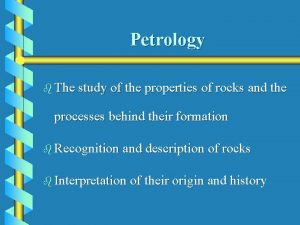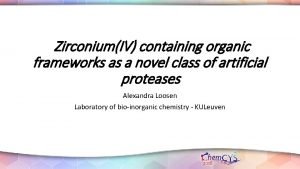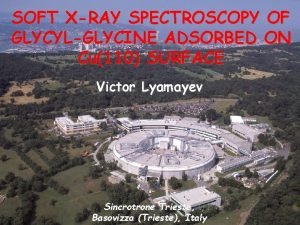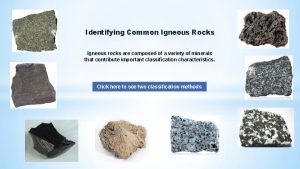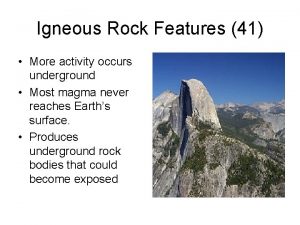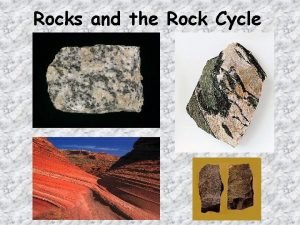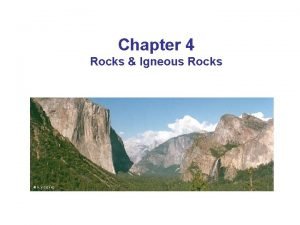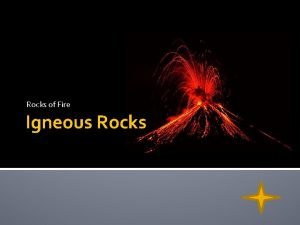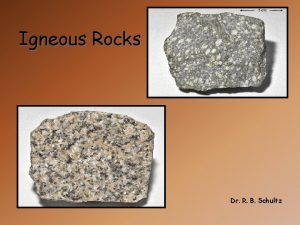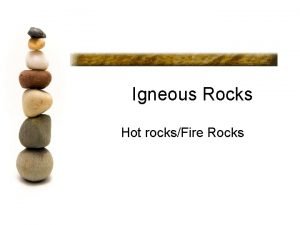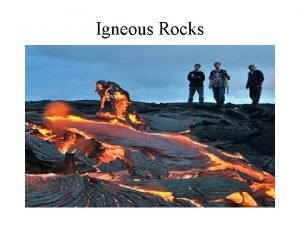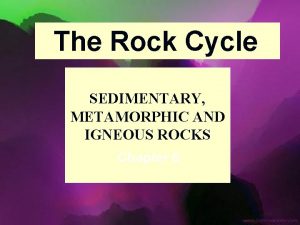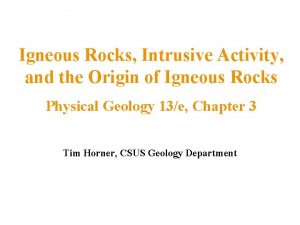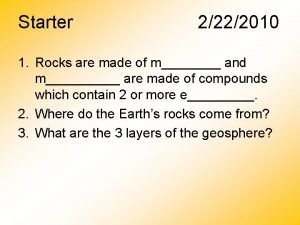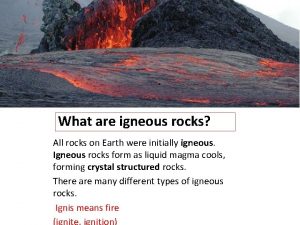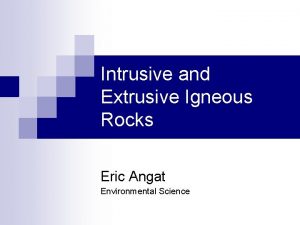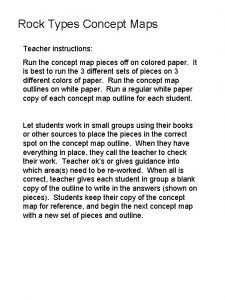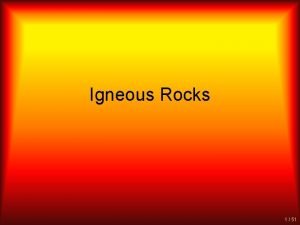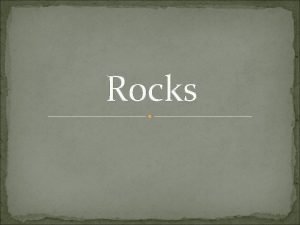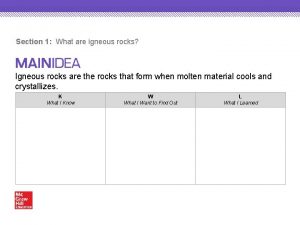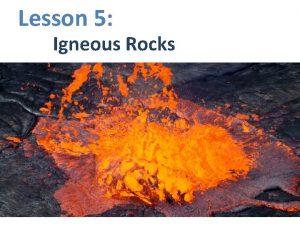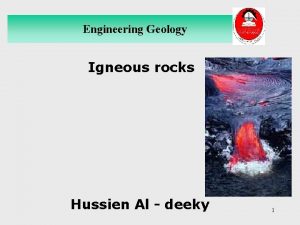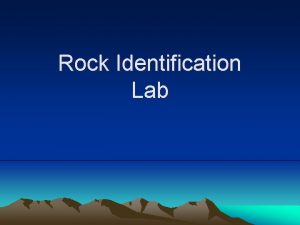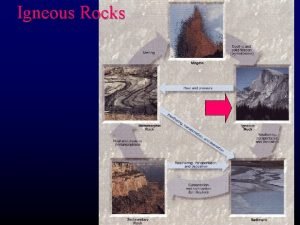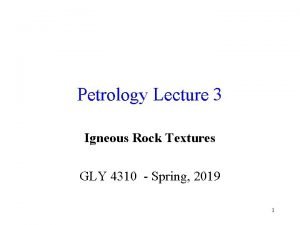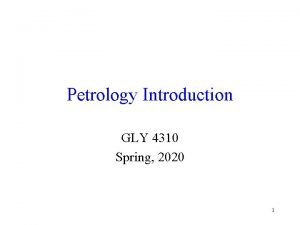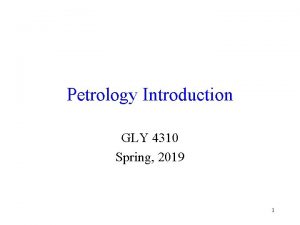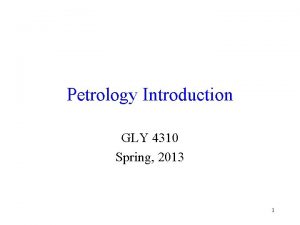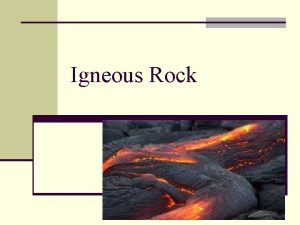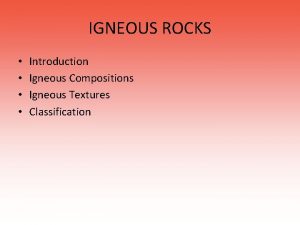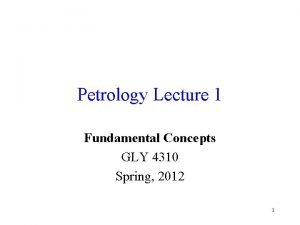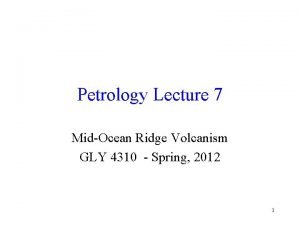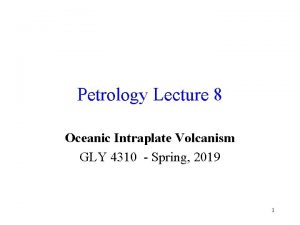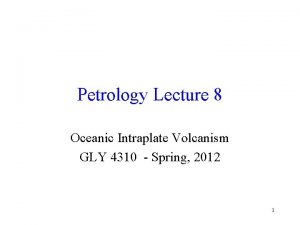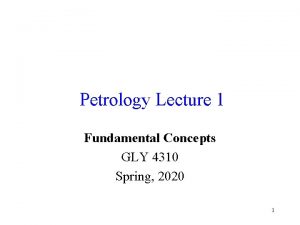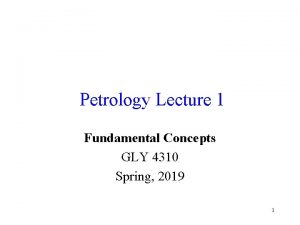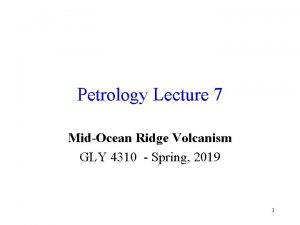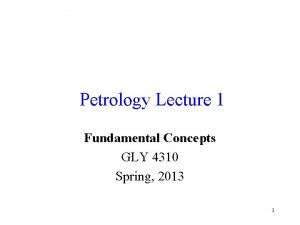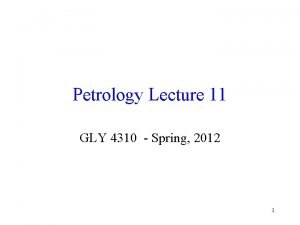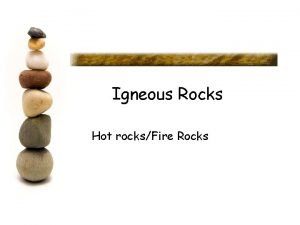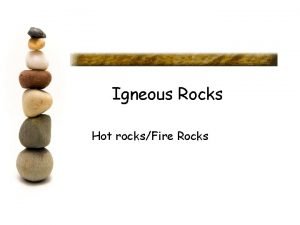Petrology Lecture 3 Igneous Rock Textures GLY 4310








































- Slides: 40

Petrology Lecture 3 Igneous Rock Textures GLY 4310 - Spring, 2011 1

Primary • Form during solidification • They result from interactions between mineral crystals and melt 2

Secondary • Develop by alteration of the rock after crystallization 3

Nucleation • Clusters of a few tens of ions are essentially all surface • Ratio of surface area/volume is fantastically high • Ions on the surface have unbalanced charges because they are not surrounded completely by other ions, and are easily disrupted • Nucleation usually requires undercooling 4

Growth • Involves the addition of ions to the nucleated cluster • Some crystals have preferred directions of growth 5

Rate of Diffusion • Controls movement of ions in many magmas • Determines the rate of dissipation of the heat of crystallization 6

Cooling Rate • Slow cooling allows system to maintain thermodynamic equilibrium • Rapid cooling contributes to a nonequilibrium system 7

Nucleation vs. Growth 8

Blue Glassy Pahoehoe • Large embayed olivine phenocryst with smaller plagioclase laths and clusters of feathery augite nucleating on plagioclase. Magnification ca. 400 X. © John Winter and Prentice Hall. 9

Blue Glassy Pahoehoe • Feathey quenced augite crystal nucleating on plagioclase and growing in a semiradiating form outwards • Mag. 2000 x © John Winter and Prentice Hall. 10

Available Liquid a b • The volume of liquid available to the edge of a crystal is larger than to a face, and a corner has even greater available liquid. (left) • The end of a slender crystal will have the largest available liquid. (right) © Chapman and Hall. London. 11

Zoned Hornblende © John Winter and Prentice Hall. • Field of view 1 mm 12

Zoned Plagioclase © John Winter and Prentice Hall. • Carlsbad twin • Field of view o. 3 mm 13

Grain Shape • • Mineral Term Euhedral Subhedral Anhedral Rock Term Idiomorphic Hypidomorphic Xenomorphic 14

Euhedral Crystal © John Winter and Prentice Hall. • Euhedral early pyroxene with late interstitial plagioclase • Field of view 5 mm 15

Dimension Relationships • • Mineral term Equant Prismatic Tabular Rock term Massive Lineated Foliated 16

Ophitic Texture © John Winter and Prentice Hall. • Pyroxene envelops plagioclase laths • Field of view 1 mm 17

Granophyric Texture © John Winter and Prentice Hall. • Quartz-alkali fldspar intergrowth • Field of view 1 mm 18

Graphic Texture © John Winter and Prentice Hall. • Single crystal of cuniform quartz intergrown with alkali feldspar 19

Pyroxene Replacing Olivine • Left – Olivine mantled by pyroxene, ppl • Right – CN – Olivine is extinct, Opx stands out • © John Winter and Prentice Hall. 20

Dehydration Rim © John Winter and Prentice Hall. • Hornblende phenocryst dehrates to Fe-oxides plus pyroxene due to pressure release on eruption 21 • Width 1 mm

Embayed Texture © John Winter and Prentice Hall. • Field of view 0. 3 mm • Partially resorbed olivine phenocryst 22

Sieve Texture © John Winter and Prentice Hall. • Plagioclase phenocrysts • Field of view 1 mm 23

Trachytic Texture • Sub-parallel alkali feldspar laths form sheaves and swirls around earliercrystallised minerals • CN, medium power 24

Pilotaxic or Felty Texture © John Winter and Prentice Hall. • Microphenocrysts are randomly aligned 25

Flow Banding © John Winter and Prentice Hall. • Andesite, Mt. Rainier • Long-handled hammer for scale 26

Intergranular Texture © John Winter and Prentice Hall. • Columbia River Basalt Group • Width 1 mm 27

Carlsbad Twin © John Winter and Prentice Hall. • Form as the result of mistakes during growth • Field of view ≈ 1 mm 28

Albite Twinning © John Winter and Prentice Hall. • Also thought to be form as the result of mistakes during growth • Field of view ≈ 1 mm 29

Tartan Twinning • Microcline • Field of view ≈ 1 mm © John Winter and Prentice Hall. 30

Deformational Albite Twinning © John Winter and Prentice Hall. • Typically occurs in nearly pure Ab • Note that twins “pinch-out” at the edge • Width 1 mm 31

Exsolution Textures • Perthite - The host is K-spar, with albite lamellae appearing as a coherent intergrowth § Coherent means the exsolved phase lattices have a specific relationship to the host lattice. • Antiperthite - The host is albite, with K-spar lamellae showing a coherent intergrowth 32

Types of Perthite • In perthite, intergrowths may sometimes be seen by the unaided eye • In microperthite, however, they are distinguishable only microscopically • In cryptoperthite the crystals are so small that the separation can be detected only by X-ray diffraction • Perthite was originally thought to be a single mineral, described at a locality near Perth, Ontario, from which its name is derived 33

Bronzite Photomicrograph • Bronzite crystal from an ultramafic rock • Thin lamellae of a calciumrich species, probably pigeonite, have separated from the bronzite, and the host (grayish) thus has a very low calcium content (magnified about 40×) 34

Augite Pigeonite • Complex separation of augite from an inverted pigeonite (magnified about 70. 4×) 35

Ocelli • Liquid immiscibility can produce spherical to ovoid inclusions, ranging in size from mm's to a few cm's • Intermixing of magmas may form ocelli by the suspension of blobs of one magma in another 36

Post-Solidification Processes • Autometamorphic • Deuteric • Diagenetic 37

Deuteric Reactions • Uralization § Symplectite • • • Biotitization Chloritization Seritization Saussuritization Serpentization 38

Uralite Pyx Hbl © John Winter and Prentice Hall • Pyroxene largely replaced by hornblende • Width 1 mm 39

Chloritization © John Winter and Prentice Hall • Chlorite (light) replaces biotite (dark) at the rim and along cleavages • Width 0. 3 mm 40
 Types of igneous rock
Types of igneous rock Rg 4310/2018
Rg 4310/2018 Petrology is the study of
Petrology is the study of Igneous rock to metamorphic rock
Igneous rock to metamorphic rock Rock cycle facts
Rock cycle facts Gly
Gly Gly
Gly Complexes of the type m(aa)3 ±n show
Complexes of the type m(aa)3 ±n show Rock textures chart
Rock textures chart Intrusive igneous rock bodies are called
Intrusive igneous rock bodies are called Igneous rock
Igneous rock Igneous rock
Igneous rock Concept map about rocks and minerals
Concept map about rocks and minerals Igneous rocks appearance
Igneous rocks appearance Igneous rock defintion
Igneous rock defintion Igneous rock texture
Igneous rock texture Igneous rocks
Igneous rocks Melted minerals
Melted minerals Topography associated with massive igneous rocks
Topography associated with massive igneous rocks Rock cycle song (sedimentary igneous metamorphic)
Rock cycle song (sedimentary igneous metamorphic) Pumice extrusive or intrusive
Pumice extrusive or intrusive What is the definition of an igneous rock
What is the definition of an igneous rock Igneous rock
Igneous rock Igneous rock types
Igneous rock types Initially all rocks on earth were
Initially all rocks on earth were Intrusive vs extrusive igneous rocks
Intrusive vs extrusive igneous rocks Igneous rock concept map
Igneous rock concept map Types of igneous rocks
Types of igneous rocks Scoria silica content
Scoria silica content Fine grained igneous rock
Fine grained igneous rock Igneous rock animation
Igneous rock animation Mafic extrusive igneous rock examples
Mafic extrusive igneous rock examples Igneous rock colors
Igneous rock colors Non-banded grains
Non-banded grains Difference between pumice and scoria
Difference between pumice and scoria Rock cycle crayon lab answer key
Rock cycle crayon lab answer key How is magma formed
How is magma formed Felsic composition
Felsic composition Igneous rock formation
Igneous rock formation Define igneous rock
Define igneous rock Igneous rocks
Igneous rocks


